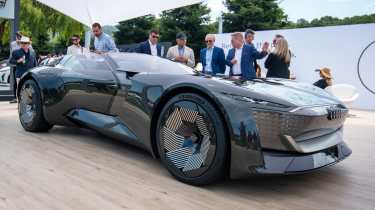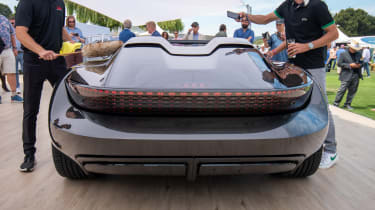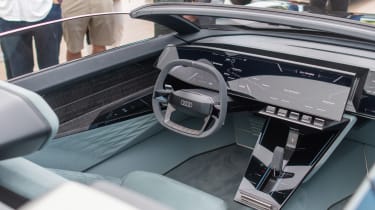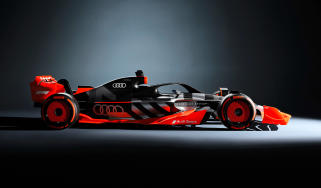Audi Sky Sphere Concept previews future design direction
Open-top GT first of three visionary concept cars which will underpin Audi’s aesthetic in years to come
You could say that Tesla has had an innate advantage over so-called ‘legacy’ manufacturers when it comes to marketing, and ultimately selling, electric cars. Free from historical precedent and the pressure of maintaining customer expectations, Elon Musk and his team at Tesla have been able to use that fresh perspective to create products that are desirable in a different way. So how does one even begin to fathom the job of revitalising an existing brand such as Audi for electrification, especially when its defining visual element, the single-frame grille, is one that’s no longer relevant? One way is the creation of concept cars to preview that journey, something Audi will do with three different examples to be revealed this year, starting with this Sky Sphere Concept that will debut on the lawn at Pebble Beach.
The Sky Sphere Concept is just that: a design concept with no specific relation to a forthcoming sports car or GT. Instead, it is the establishment of a broader new aesthetic that will find its way onto other Audis. This is a curious form to do such a thing with, given the lack of connection between what many would consider an engaging sports car and the electrified and autonomous agenda being previewed by this concept.
> Audi A6 e-tron Concept previews new electric saloon
Audi has approached this discombobulation with a clever device that highlights the concept’s duality by giving it the ability to alter the length of its wheelbase. This movement physically transforms the car’s proportions and interior, but also reiterates the historic role that those proportions have played in automotive design. When in ‘GT’ mode, the extra 250mm of length gained within the wheelbase is derived not in the cabin, but between the front wheels and windscreen, referencing and accentuating the long dash-to-axle ratio historically found in luxurious and glamorous GTs. In this mode, the Sky Sphere is also entirely autonomous, with a steering wheel hidden away underneath the dash and the vast digital interface democratically placed within the cabin.
However, the Sky Sphere then changes dramatically when ‘Sport’ mode is selected, as alongside the shortening of its wheelbase, so too do the car’s proportions transform into ones more associated with those of sports cars, and the added agility and dynamism they signify. This is also when the cabin reverts back to a form more relatable to today, with a steering wheel in place and the interfaces now canted towards the driver. Yet this transformational element to the Sky Sphere is perhaps less relevant to what Audi might one day bring to market. Rather it’s the exterior styling that is its more enticing element.
The Sky Sphere Concept’s design itself could almost be called neoclassical – a contemporary take on the sort of silhouette that has been in constant use since the origin of the high-performance GT. The flowing, cab-back and muscle-bound aesthetic is one that can be referenced on anything from the Jaguar XK120 of the late ’40s to a Bentley Continental of the ’50s or even a short-wheelbase Ferrari 250 from the ’60s. This is in direct contrast to Audi’s historical design path that’s largely been centred around models famed for their rallying success from a much later period.
In practice the Sky Sphere Concept is superbly executed, with a high level of refinement and sophistication to the surfacing that’s been missing in previous Audi concept cars. It looks, more than anything, like a labour of love from Audi’s Californian design team who were responsible for its execution. The forms, intersections and layering of materials, both in its bodywork and detailing, are finely wrought and well-considered.
And what of the single-frame grille? It’s no longer single, rather it features an almost cheeky reference to the grille designs that directly preceded the introduction of the iconic graphic. Its top and bottom ends are now broken by a glazed section with both light and texture underneath. The single frame isn’t completely broken, as it can be reconnected with lighting elements to re-establish the iconic motif – this also changes depending on the selected mode. The rest of the lighting is merely a second act to the overall design, blending seamlessly at the rear within the impossibly tapered glazed tail, leaving just the tiny headlights up front to perhaps be the only production-relevant shape visible.
The chassis and powertrain aren’t particularly relevant for such a concept, but Audi has confirmed it uses a single electric motor on the rear axle and an 80kWh battery package that together are able to produce 623bhp and 553lb ft of torque. Weight is projected to be around 1800kg, and the Sky Sphere will reach 62mph in 4.0sec. There’s also a steer-by-wire system that controls steering derived from both axles, while the suspension is an air spring set-up.
Yet the relevance of such a concept can’t really be ascertained until it’s reflected in the cars we can find in showrooms, and as it stands Audi’s more production-biased concepts such as the A6 e-tron still have a big job to do in finding that balance between appealing to the new while not isolating the old. The Sky Sphere Concept, on the other hand, is a glimpse into a more distant future, one which legacy manufacturers such as Audi still have lots of work to do towards if they are to ensure they remain as relevant and profitable as they are now.
> Tesla Roadster delayed, again – ‘250mph’ supercar now set for 2022








